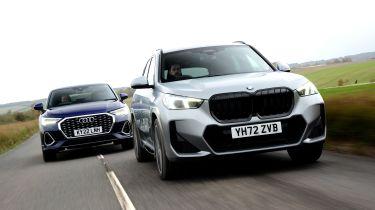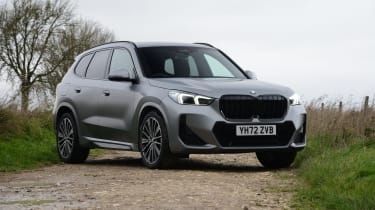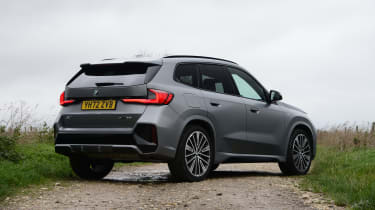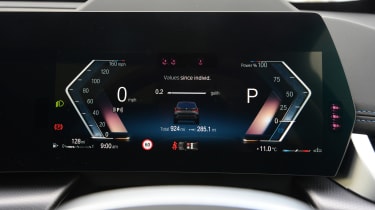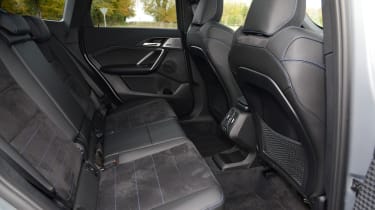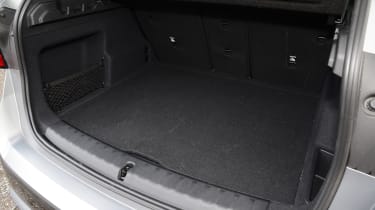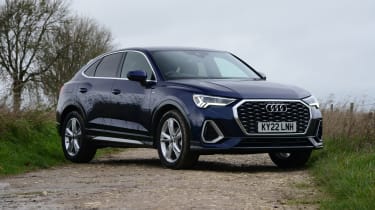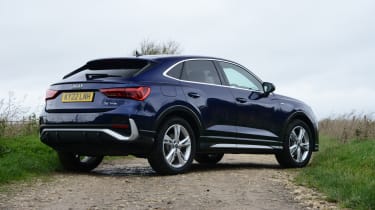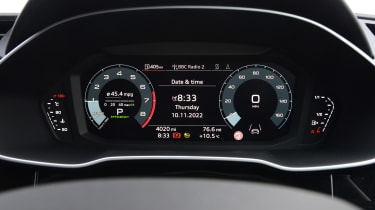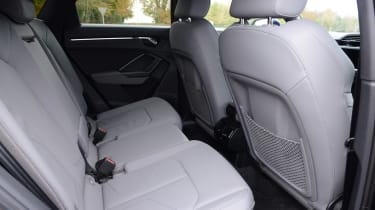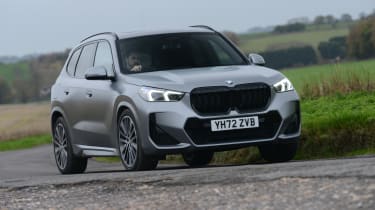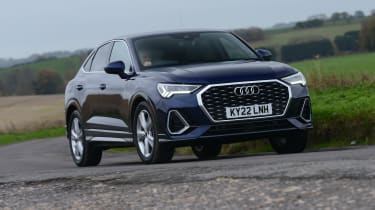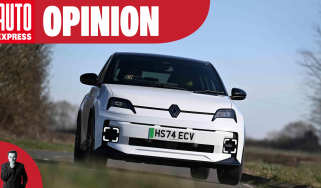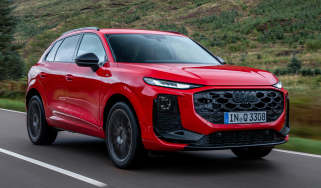BMW X1 vs Audi Q3: 2022 twin test review
There’s an all-new BMW X1 in dealers – does it have the talent to see off the current Audi Q3?
The BMW X1 has proven to be an enormous success for the brand. Its smallest SUV joined the line-up after the larger X3 and X5, and gave buyers a sniff of those grander premium models within a more modest footprint and at a less expensive price.
After 13 years and 119,000 UK sales, BMW has released the third-generation model. Its key targets for the new car were to improve practicality and tech, but we’re keen to find out what other areas BMW has sought to improve – especially in a class where there are so many strong rivals.
One of the most appealing of all is the Audi Q3. In terms of tech and load space, it’s certainly one of the cars that the BMW will need to beat. And in Sportback guise it’s one of the more striking choices in the class for the new BMW to go up against.
With BMW in such strong form across virtually its entire model line-up right now, will the X1 be able to continue this run of success? Or can the Q3 reveal a few flaws in the newcomer and overcome its rival?
BMW X1
|
Model: |
BMW X1 xDrive23i M Sport |
|
Price: |
£41,470 |
|
Engine: |
2.0-litre 4cyl turbo, 215bhp |
|
0-62mph: |
7.1 seconds |
|
WLTP economy: |
39.9mpg/8.8mpl |
|
CO2: |
154g/km |
|
Annual road tax: |
£155 |
With the M Sport trim expected to be chosen by more than half of X1 buyers, that’s the model we’re testing here. Paired with the xDrive23i powertrain, it’s priced from £41,470. With options such as the £1,500 Technology Plus pack (adding features like augmented-reality navigation and a head-up display), the £1,000 panoramic sunroof and £1,050 electric front seats, that climbs to £49,000.
Used - available now

2024 Volkswagen
Tiguan
7,482 milesAutomaticPetrol1.5L
Cash £21,449
2020 Toyota
C-HR
38,220 milesAutomaticPetrol1.8L
Cash £17,999
2024 Kia
Niro
9,131 milesAutomaticPetrol1.6L
Cash £24,699
2021 BMW
X3
99,902 milesAutomaticDiesel2.0L
Cash £19,988Design & engineering
For its third generation, the X1 has bulked up slightly, but not by as much as the square shoulders might suggest; it’s only 53mm longer, 24mm wider and 44mm taller than the outgoing model. Part of the more substantial look is due to a 31mm increase in track front and rear. There’s clearly plenty of refinement in that design, too; this petrol X1 has a coefficient of drag of 0.27, so it cuts a more efficient course through the air than its rival here.
Inside, the X1 shares much of its cabin design with the latest 2 Series Active Tourer. It looks contemporary and feels flawlessly built, but physical controls are limited to a few select areas, such as the steering wheel and floating centre console.
Electrification has become even more widespread for the latest X1, and all but the base petrol engine adopt some form of hybrid assistance. The mild-hybrid set-up in petrol and diesel models adds an electrical boost worth 19bhp and 55Nm; depending on the situation, it’ll either take load off the combustion engine to save fuel, or provide more energy for faster acceleration.
The xDrive23i here has a 2.0-litre turbo petrol engine, and combined with the hybrid tech it makes 215bhp and 360Nm of torque. Drive is sent to all four wheels via a seven-speed dual-clutch automatic gearbox. Lesser models in the range send their drive to the front wheels only. Adaptive dampers are fitted as standard, but unlike some cars that let you adjust their response, the units in the X1 constantly adapt to your driving style and road conditions.
Driving
If you’re a keen driver but feel that an SUV best suits your everyday needs, then the BMW X1 should be on your shortlist. It’s very sharp through the bends; turn in is so keen, the front end so grippy, and body roll so minimal, that only the high driving position makes you realise you’re in an SUV rather than a conventional hatchback. The steering doesn’t offer a huge amount of feedback, but at least it’s precise.
Performance is more than adequate, too. Officially, the X1 will accelerate from 0-62mph in 7.1 seconds. It delivers its power in a consistent surge, so pulls keenly throughout the rev range. The mild-hybrid tech works seamlessly, allowing the engine to cut in and out when coasting or when shuffling along in traffic.
However, there are parts of the X1 experience that could be better. The first is the gearbox; it’s reasonably smooth on a country road, but very laggy when pulling away from a standstill or at low speeds. It means that if you want to merge into moving traffic when joining a roundabout, for example, you’ll either need to plan well ahead or exercise a lot of patience if you want to avoid floundering in the path of an approaching vehicle. It’s slightly frustrating for a vehicle that is quite rapid in all other situations.
More disappointing than the gearbox, though, is the ride quality. While the firm set-up has undoubtedly helped the handling, it means that in everyday driving, the X1 can feel a little fidgety. Our test car also had 20-inch wheels – the largest available – and firmer M Sport suspension, so this will be the most uncompromising set-up available.
But for a car that isn’t an out-and-out performance SUV, we’d have preferred a little more give. Elsewhere, refinement is excellent, with wind, road and engine noise all impressively isolated from the cabin.
Practicality
At 540 litres, the X1 has one of the largest boots in its segment. That includes a fairly generous under-floor area, which can store a soft bag or two, while a 12-volt socket is ideal for powering accessories. All versions come with a 40:20:40 split rear seat; with this dropped, the total volume grows to 1,545 litres.
The seat backs recline, and for an extra £300 the bases slide back and forth, too. Passengers are treated to generous knee room – as with the boot, the X1’s back seats are better than pretty much all of its rivals.
Storage is decent on the whole, but the floating centre console means that covered areas are at a premium. The small space you do get is hinged away from the driver, too, clearly a remnant of the car’s switch from left to right-hand drive.
Ownership
Neither BMW nor Audi covered themselves in glory in our most recent Driver Power owner satisfaction survey.
Of the 29 brands covered, BMW finished in the mid table, while Audi took 22nd place. For the dealers, it was BMW that fared worse; its network ranked 15 out of the 16 surveyed, with Audi scoring only a little better, in ninth.
Running costs
Official WLTP data suggests the X1 can do 42.2mpg – impressive considering the performance on offer. In the real world, we came very close to matching that, too – 39.9mpg shows that the mild-hybrid system and slippery body both work well. By contrast, the Q3 is capable of a WLTP-rated 34.9mpg.
At 184g/km, the Audi’s CO2 emissions are 30g/km higher than the X1’s, too. The BMW and Audi respectively sit in the 36 and 37 per cent Benefit-in-Kind tax bands, but it’s the plug-in hybrid models that will make sense for company car users, while the all-electric iX1 will be even more tax.
Tester’s notes: “Two PHEVs join the X1 line-up soon. At 322bhp, the 30e will be the most powerful model in the X1 range, yet it’ll do up to 57 miles in fully electric mode.”
Audi Q3
|
Model: |
Audi Q3 Sportback 40 TFSI quattro S line |
|
Price: |
£39,970 |
|
Engine: |
2.0-litre 4cyl turbo, 187bhp |
|
0-62mph: |
7.3 seconds |
|
WLTP economy: |
34.9mpg/7.7mpl |
|
CO2: |
184g/km |
|
Annual road tax: |
£165 |
The Audi Q3 has been around for some years now, but does it still have the ability to match the newcomer from BMW? While the car pictured is a 35 TFSI, we’re testing the Q3 in more powerful 40 TFSI guise, which at £39,970 in S line trim and the Sportback body, undercuts its rival on price.
Design & engineering
At 4,500mm long, the Q3 is the same length as the BMW to the millimetre. The X1 is only 2mm wider and has a 12mm longer wheelbase, too, yet up close, the Q3 looks significantly more rakish than the upright BMW. That all comes down to height. At 1,642mm, the X1’s roof line is 75mm taller than the Audi’s, which lends the BMW a much more imposing SUV appearance.
Inside, the Q3’s layout is starting to show its age next to the X1’s ultra-contemporary approach. That doesn’t mean it’s all negative, though; in fact, there are some areas that show real high quality. Unlike the BMW – and indeed most newer Audis – the Q3 still uses physical switches for the climate controls. The dials and buttons all operate with a satisfying click – a tactile feeling of quality that is lost in cars filled with touch-sensitive keys.
However, there are other areas where the Q3’s cabin isn’t so strong. Take the panel below the climate switches – apart from one offset volume knob, it’s a large expanse of cheap-feeling plastic. Overall, the BMW’s cabin feels more modern.
The Q3 uses the MQB platform that forms the basis of not only other Audis such as the A3 and TT, but also a huge number of vehicles throughout the wider Volkswagen Group. That gives the Q3 access to a large range of engine options, from a 1.5-litre turbocharged petrol to the storming 395bhp RS Q3. Between those two extremes are a fuel-saving 45 TFSI e PHEV, a pair of diesels and two further petrols. The closest of those to the X1 xDrive23i’s powertrain is the 40 TFSI’s 187bhp 2.0-litre four-cylinder. While the Q3 lacks a fully electric option, Audi fills that gap with the Q4 e tron.
Driving
Jump from the X1 into the Q3, and it only takes a few yards to appreciate just how stiffly sprung the BMW is when compared with its rival. Where the X1 transmits every bump into the cabin, the Q3 is noticeably smoother and softer. When you do hit a more severe bump, the noise isn’t quite as well suppressed as in the X1, but even so, we’d prefer to spend time in the Audi if we planned to do plenty of town driving.
The flipside of this is that the Audi handles nowhere near as sharply as the X1. Still, it’s capable enough, with decent grip and a secure feeling both through the turns and at speed. The steering is fairly light, but the rack is well matched to the response of the chassis. At those higher speeds, it’s clear that the Audi isn’t quite as refined as the BMW, with tyre roar becoming more audible in the cabin.
At 7.3 seconds, the Q3’s 0-62mph time is only marginally behind the X1’s, although the engine sounds a little more audible throughout the rev range. As with the BMW, the Audi’s petrol engine is connected to a seven-speed dual-clutch gearbox. It’s also far from perfect, being generally a little slower to respond to the driver’s inputs, whether that’s waiting for it to kickdown or when taking manual control with the gear selector on the centre console. It’s a little jerky at parking speeds, too, but there isn’t as much lag as in the BMW when trying to pull away.
Practicality
Even in swoopier Sportback guise, the Q3 isn’t short on boot space. At 530 litres of volume to the window line, it offers exactly the same capacity as the standard Q3, and the boot is just 10 litres smaller than the X1’s.
As with the BMW, a sliding bench is available that helps to grow that capacity further. The space itself covers a wide area, but it isn’t quite as tall as the X1’s cargo bay; the boot floor is a little higher, so it means a little more effort is needed to lift heavy items inside. It’s possible to add a 12-volt socket, but it’s part of the £210 Storage Pack, which also brings map pockets on the backs of the front seats – something that we’d expect to be standard anyway.
Once you’re sitting in the back, you’ll probably decide to leave the bench in its rearmost position. While the back row of the X1 is just about usable when it’s all the way forwards, in the Q3 it almost presses the squab into the backrest of the front seat – even when the driver’s seat is set for somebody of average height.
The outer seats are comfortable because they have decent bolstering at either side, but that comes at the expense of the central seat, which is narrow and firm. Fold the backrests down completely for maximum cargo space, and total volume grows to 1,400 litres, which is 125 litres less than the Q3 SUV and 145 litres behind its rival here. Cabin storage is well thought out, with big door bins, a pair of cup- holders and a generous covered cubby beneath the centre armrest all useful for holding various items.
Ownership
The Q3 bagged the maximum five-star rating from Euro NCAP when it was crash tested in 2018. Adult and child occupant protection scores of 95 and 86 per cent respectively are both excellent, while its safety assist mark of 85 per cent was the best of any vehicle assessed that year. The X1 has already been tested to the higher standards set for 2022, and yet it still earned a five-star rating.
Running costs
For private buyers, strong residual values are very important, and it’s the Q3 which comes out on top here. This Sportback model in 40 TFSI S line trim is predicted to hold on to 63.4 per cent of its original value after three years or 36,000 miles. The X1 can’t match that, but it’s still pretty strong, clinging on to 56.1 per cent over the same period.
Verdict
First place: BMW X1
Revamps to the X1 haven’t made much difference to what was already a winning formula. In truth, every car in this segment has its flaws, and the BMW’s – an overly firm ride – can be partially put down to the spec of our test car. In most other respects, it’s a great effort; there’s loads of space, fantastic in-car tech, it handles well and fuel economy is impressive, given the performance on offer.
Second place: Audi Q3
Given that the BMW is new and the Q3 has been around for some time, the margin between this pair isn’t as wide as we’d expected. That mainly comes down to the Audi being the more relaxing car to drive, plus its tech works well and even in Sportback form, boot space is great. However, it’s cramped in the back and more costly than its rival on monthly payments, so it takes second.
Other options in this category
Alfa Romeo Tonale Veloce
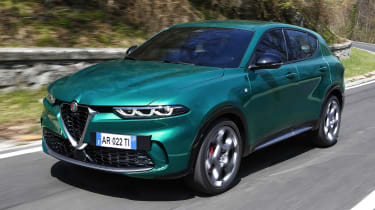
- Price: £42,495
- Engine: 1.5-litre 4cyl, 158bhp
Alfa knows how to make a stylish entrance, and the new Tonale joins the class with such a pretty design that it’ll be enough to swing many buyers. Others will find a pricey car that’s let down by an underwhelming hybrid powertrain, though.
Mercedes GLA 200 AMG Line Premium
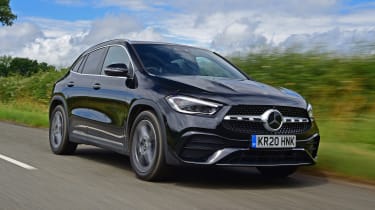
- Price: £40,645
- Engine: 2.0-litre 4cyl, 161bhp
In the face of the new X1, the GLA’s reign as our Small Premium SUV of the Year is under threat. The Mercedes has fabulous tech and a roomy cabin, but the BMW is more refined, more fun to drive, more practical and offers stronger performance.
Figures
|
BMW X1 xDrive23i M Sport |
Audi Q3 Sportback 40 TFSI S line quattro | |
|
On the road price/total as tested |
£41,470/£49,000 |
£39,970/£39,970 |
|
Residual value (after 3yrs/36,000) |
£23,273/56.1% |
£25,353/63.4% |
|
Depreciation |
£18,197 |
£14,617 |
|
Annual tax liability std/higher rate |
£2,966/£5,932 |
£2,336/£4,672 |
|
Annual fuel cost (12k/20k miles) |
£2,605/£4,341 |
£2,978/£4,963* |
|
Insurance group/quote/VED |
31/£701/£155 |
32/£557/£165 |
|
Cost of 1st/2nd/3rd service |
£786 (4 years) |
£540 (2 years) |
|
Length/wheelbase |
4,500/2,692mm |
4,500/2,680mm |
|
Height/width |
1,642/1,845mm |
1,567/1,843mm |
|
Engine |
4cyl in-line/1,998cc |
4cyl in-line/1,498cc |
|
Peak power/revs |
215/5,000 bhp/rpm |
187/4,200 bhp/rpm |
|
Peak torque/revs |
360/1,500 Nm/rpm |
320/1,500 Nm/rpm |
|
Transmission |
7-spd auto/4WD |
7-spd auto/4WD |
|
Fuel tank capacity/spare wheel |
47 litres/repair kit |
60 litres/£125 |
|
Boot capacity (seats up/down) |
540/1,545 litres |
530/1,400 litres |
|
Kerbweight/payload/towing weight |
1,730/490/2,000kg |
1,620/580/2,000kg |
|
Turning circle |
11.7 metres |
11.8 metres |
|
Basic warranty (miles)/recovery |
3yrs (unlimited)/3yrs |
3yrs (60k)/3yrs |
|
Driver Power manufacturer |
16th/15th |
22nd/9th |
|
NCAP: Adult/child/ped./assist/stars |
86/89/76/92/5 (’22) |
95/86/76/85/5 (’18) |
|
0-62mph/top speed |
7.1 secs/145mph |
7.3 secs/136mph |
|
Test economy (mpg/mpl)/range |
39.9/8.8/413 miles |
34.9/7.7/461 miles |
|
WLTP combined |
42.2mpg |
34.9mpg |
|
WLTP combined |
9.3mpl |
7.7mpl |
|
Actual/claimed CO2/tax bracket |
164/154g/km/36% |
N/A/184g/km/37% |
|
Airbags/Isofix/park sensors/camera |
Yes/yes/f&r/yes |
Yes/yes/rear/£1,195^ |
|
Auto box/lane keep/blindspot/AEB |
Yes/yes/yes/yes |
Yes/yes/£800^/yes |
|
Climate control/adaptive cruise |
Yes/yes |
Yes/yes |
|
Leather/heated seats |
£1,150/yes |
No/£1,195^ |
|
Metallic paint/LED lights |
£595/yes |
£575/yes |
|
Keyless entry & go/powered tailgate |
Yes/yes |
Yes/no |
|
Sat-nav/digital dashboard |
Yes/yes |
Yes/yes |
|
DAB radio/connected services |
Yes/yes |
Yes/yes |
|
Wireless charge/CarPlay/Android Auto |
Yes/yes/yes |
No/yes/yes |
Now read our list of the best small SUVs…
